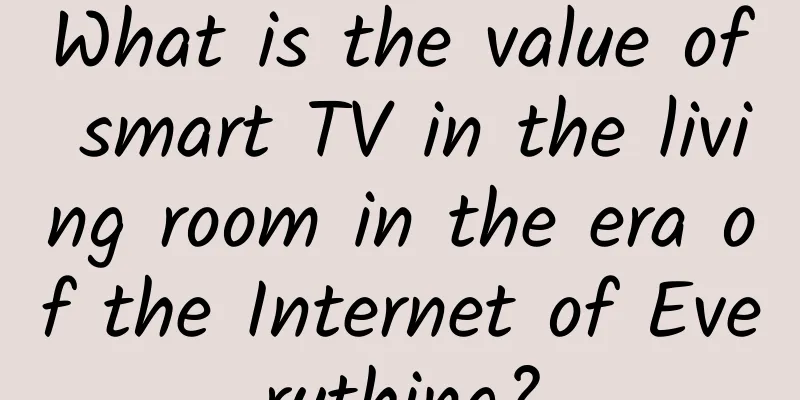What is the value of smart TV in the living room in the era of the Internet of Everything?

|
Ten years ago, the Internet of Everything seemed to exist only in movies, and many people dreamed of being able to talk to machines and enjoy home services brought by intelligent AI in their lifetime. With the vigorous development of the Internet, this movie plot that was out of reach at the time has finally reappeared in real life, in every family and around every person. At present, the information of home interconnection always needs a display terminal, and in the home use scenario, people spend the most time on the device with a screen - smart TV. TV is considered to be the most important screen in the home use scenario and an excellent entry point for realizing home interconnection in the future. People need TVs, in fact, they mainly need two most critical functions, one is display capability, and the other is video processing capability, but in fact these two capabilities are not essentially related, especially in the era of smart home where everything is connected. The separation of screen and host is inevitable. The current box is still in its early stages, and there may be more products with different forms and functions in the future. After the separation, the question arises, why can't the box be connected and aggregated with other smart devices such as smart speakers? In this way, even if it is a TV product that is not often used in the bedroom, we can use it to control other devices in the living room. As for the separated product form, it will depend on people's core needs. Each group of people has different choices. Some people focus on video, some focus on sound, etc. This prompts hardware manufacturers to launch different types of products. This is different from traditional TVs. People used to think that the screen was the key and pursued display effects. The functions of TVs were similar, but with the separation of the screen and the host, there is a huge space for choice. In the future, the form of smart TV will undoubtedly change. The physical screen may disappear. With the emergence of artificial intelligence, voice, face and other cognitive perceptions, remote controls will no longer be necessary. As technology continues to mature, the impact of smart TVs on home connectivity will grow. First is cloud services, which store user data in the cloud. Users can access their data at any time and any place using any device that can connect to the Internet. Cloud services are becoming an indispensable part of home connectivity. Second is big data, which will affect the accuracy of user portraits. Through big data technology, user behavior will become an analyzable and predictable existence. Finally, there is artificial intelligence (AI) technology, which is developing more and more beyond people's expectations. It keeps moving forward every year, causing quantitative changes to lead to qualitative changes. It can be predicted that the concept of smart home with smart TV as the core will eventually land and form new services. Smart TVs have now brought many users back to the living room. According to iQiyi's data, the OTT traffic from smart TVs has surpassed the PC side to become the second largest traffic entrance for iQiyi. In addition to selling hardware, you can also sell boot ads. In addition to PC, OTT has also become a very important channel for monetization. This is the biggest change that smart TVs have brought to the industry. From the advertising market, there will be a large demand for advertising in the future due to smart homes and IoT devices, and smart TV will be a major channel. The market value of the entire OTT advertising market this year is 2 billion, which is obviously low. In the large-screen market of traditional TVs, it is 100 billion a year, and there is still a lot of room for growth between 2 billion and 100 billion. In addition, the shipment volume of smart TVs and the monthly active volume are slowly approaching traditional TVs, and even have the momentum to surpass it. This is also a very huge market. As a home product with built-in media attributes, television has a natural advantage in promoting technological life. The large screen can also convey better advertising content. If other smart home products can be connected to the TV and combined with market demand, the living room value of smart TV will be further explored, and the future technological life will definitely be better. As a winner of Toutiao's Qingyun Plan and Baijiahao's Bai+ Plan, the 2019 Baidu Digital Author of the Year, the Baijiahao's Most Popular Author in the Technology Field, the 2019 Sogou Technology and Culture Author, and the 2021 Baijiahao Quarterly Influential Creator, he has won many awards, including the 2013 Sohu Best Industry Media Person, the 2015 China New Media Entrepreneurship Competition Beijing Third Place, the 2015 Guangmang Experience Award, the 2015 China New Media Entrepreneurship Competition Finals Third Place, and the 2018 Baidu Dynamic Annual Powerful Celebrity. |
<<: "91 Ten Articles" - A daily must-read briefing for the new energy vehicle industry (210210)
Recommend
Why doesn't New Zealand build a cross-sea bridge between its North and South Islands?
New Zealand is located southeast of Australia, ac...
Tutorial: How to reduce the size of iOS app?
Q: How can I make my program installation package...
Zhihu information flow: a "small trend" in advertising promotion and marketing in 2019!
On the first day of 2019, Luo Zhenyu's New Ye...
Sony selflessly contributes LDAC: Android O wireless sound quality explodes
Earlier, there were rumors that Google's next-...
Practical sharing: about the logic of writing strategies and plans
Today I would like to share with you the writing ...
A complete summary of the offline event planning process!
For advertisers, offline event planning is no str...
A girl in Shandong fell to her death in a shopping mall. Be careful of these 6 "safety risk points" →
On the evening of November 16, a heart-wrenching ...
The summer heat is about to dissipate, but do you still not know who sings the familiar "background music" of summer?
Although the dog days are over, summer in Chongqi...
8 years of Double 11: What else can we see besides pessimism and doubt?
120.7 billion, a year-on-year increase of 32.3%. ...
Why does this new material developed from "chemical disorder" become a "treasure alloy"?
Recently, the article "Liquid Metal for the ...
How much does it cost to customize the Korla wood mini program?
The mini program provides convenience for publici...
Saturn's rings are getting darker? Don't worry, they're still there
Author: Zeng Heng Duan Yuechu On the stage of the...
Better display? The difference between HDR and UHD technology revealed
Friends who are interested in display technology k...
[Popular Science of Chinese Military Technology] How difficult is it to build a modern warship with stealth capabilities?
With the development of modern detection equipmen...
How to operate private domain traffic community?
Many people who want to start private domain comm...









